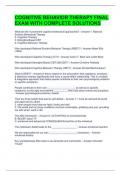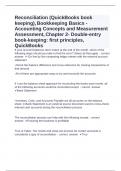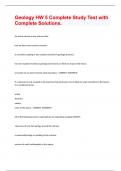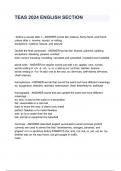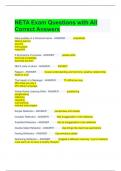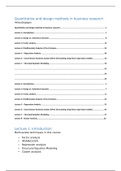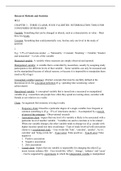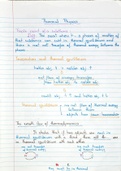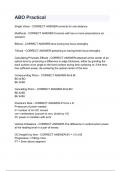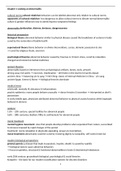EXAM WITH COMPLETE SOLUTIONS
What are the 4 prominent cognitive-behavioral approaches? - Answer-1. Rational
Emotive Behavioral Therapy
2. Cognitive Therapy
3. Strengths-Based CBT
4. Cognitive Behavior Therapy
Who developed Rational Emotive Behavior Therapy (REBT)? - Answer-Albert Ellis
(1955)
Who developed Cognitive Therapy (CT)? - Answer-Aaron T. Beck and Judith Beck
Who developed Strengths-Based CBT (SB-CBT)? - Answer-Christine Padesky
Who developed Cognitive Behavior Therapy (CBT)? - Answer-Donald Meichenbaum
What is REBT? - Answer-A theory based on the assumption that cognitions, emotions,
& behaviors interact significantly and have a cause-effect relationship. This is a holistic
& integrative approach that states people contribute to their own psychological problems
or specific symptoms.
People contribute to their own __________ __________ as well as to specific
symptoms, by the rigid and extreme __________ they hold about events and situations.
- Answer-psychological problems, beliefs
Their are three beliefs that lead to self-defeat: - Answer-1. I must do well and be loved
and approved by others
2. other people must treat me fairly, kindly and well
3. The world and my living conditions must be comfortable, gratifying and just, providing
me with what I want in life.
The ABC framework: - Answer-A: ACTIVATING an event/adversity
B: BELIEF about "A"
C: emotional and behavioral CONSEQUENCE/reaCtion of the individual
The individual's belief leads to the ________ __________ - Answer-emotional reaction
We are responsible for our own _________ ___________ (reactions). - Answer-
emotional destiny
Key words/phrases Ellis looks to as demands and commands: - Answer-"shoulds"
"musts"
, "oughts"
What comes after the client comes in with the "ABC" model? - Answer-D & E
D & E stand for... - Answer-D: DISPUTING irrational beliefs through detecting, debating,
and discriminating.
E: creating a new and EFFECTIVE philosophy/belief system
Therapeutic goals for REBT - Answer--minimize emotional disturbances and self-
defeating behaviors by acquiring a more realistic and compassionate philosophy of life
-help clients differentiate between realistic and unrealistic goals
-assist clients to achieve Unconditional Self-Acceptance (USA), Unconditional Other-
Acceptance (USO) and Unconditional Life-Acceptance (ULA)
Therapist's function and role in REBT (4 steps): - Answer-1. identify client's irrational
beliefs and absolutes & disputes them
2. demonstrate how clients are keeping their emotional disturbance active by continuing
to think illogically.
3. help clients change their thinking and minimize their irrational ideas
4. encourage clients to develop a rational philosophy of life
**question beliefs**
Client's REBT experience - Answer--focus on present experiences
-actively working in and out of therapy sessions
-homework assignment completion and is checked by therapist
-transference is not encouraged
-end of therapy focuses on progress review, making plans and identifying strategies to
prevent or cope with challenges
REBT relationship between therapist and client: - Answer--collaborative
-psychoeducational
-insight+ACTION
-warmth not required but will enhance the process
-demystifies the therapeutic process
-unconditional acceptance of client and teach client USA, UOA, ULA
How is REBT applied? - Answer-The use of different modalities (cognitive, emotive,
behavioral and interpersonal) to dispel self-defeating cognitions and to teach people
how to acquire a rational approach to living.
Cognitive methods used in REBT: - Answer--disputing irrational beliefs
-cognitive HW
-bibliotherapy
-change of language
-psychoeducational methods

